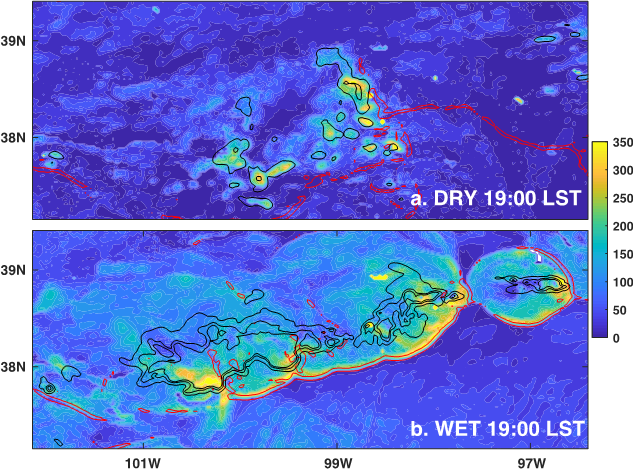Simulating the effects of surface energy partitioning on convective organization
Submitter
Williams, Ian N.
— Lawrence Berkeley National Laboratory
Area of Research
Surface Properties
Journal Reference
Dai Y, I Williams, and S Qiu. 2020. "Simulating the effects of surface energy partitioning on convective organization: Case study and observations in the US Southern Great Plains." Journal of Geophysical Research: Atmospheres, 126(2), e2020JD033821, 10.1029/2020JD033821.
Science

Figure 1. (a) Surface latent heat (shaded) flux during a passage of a weak squall line on 2006-08-10 for (a) DRY and (b) WET soil perturbation. Red contours indicate gust fronts (vertical velocity larger than 0.5 m/s), while black contours indicate rain rates of 1, 5, and 10 mm/h. Note that large latent heat flux correlates with gust fronts, instead of large rain rates in WET. From journal.
Simulations reveal that wet soil can lead to better organized convection than dry, constituting a positive rainfall feedback, despite earlier triggering over dry soil. The effects of cold pools on convective organization vary with surface wetness and convective life cycle stage.
Impact
The overall positive feedback of soil moisture to convective organization could contribute to heavy precipitation extremes. The varied cold-pool effects provide new ideas for cold-pool parameterization in climate models. Lastly, enhanced surface latent heat flux along gust fronts as seen in both models and U.S. Department of Energy Atmospheric Radiation Measurement (ARM) user facility observations provides additional positive feedback that may help convection persist after sunset.
Summary
Realistic cloud-resolving simulations were performed to study the effects of surface energy partitioning (surface sensible and latent heat fluxes) on the organization of isolated convection into larger mesoscale convective systems (MCSs) near the U.S. Southern Great Plains. The role of cold pools in mediating surface-convection interactions was explored. Better organized MCSs tended to occur in the experiments with perturbed wetter soil (and more active vegetation), regardless of the effects of soil moisture on the diurnal timing of convective triggering. Wetter soil led to shallower boundary layers and more convective available potential energy than drier soil. The roles of cold pools on convection are life-cycle-stage dependent: A dry surface allows more numerous colliding cold pools, thereby aiding in convective triggering by reducing entrainment in the early stages, and providing gust-front uplift in later stages. However, horizontal propagation of the cold-pool density current can outrun the convective system, creating a slantwise updraft and thus weakening the gust front uplift in later stages. This effect calls into question previous cold-pool parameterizations, in which the gust front uplift is mainly proportional to the negative buoyancy of cold air. Lastly, both the model and ARM observation show an enhancement of surface latent heat flux during the passage of a gust front at night, suggesting that a positive feedback between the surface and convection helps MCSs to persist into the nighttime.
Keep up with the Atmospheric Observer
Updates on ARM news, events, and opportunities delivered to your inbox
ARM User Profile
ARM welcomes users from all institutions and nations. A free ARM user account is needed to access ARM data.


















